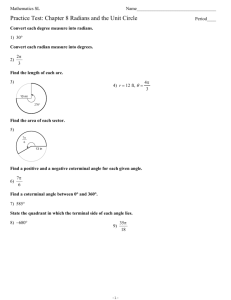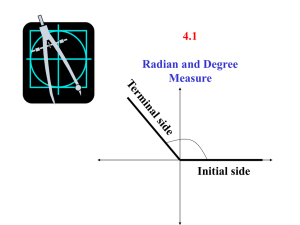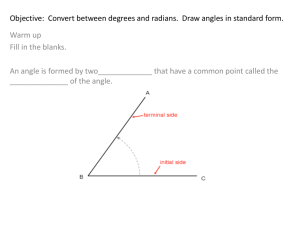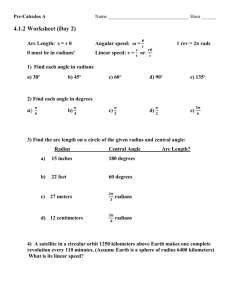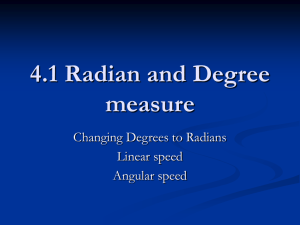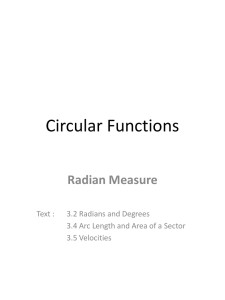13.2 General angles and radians
advertisement
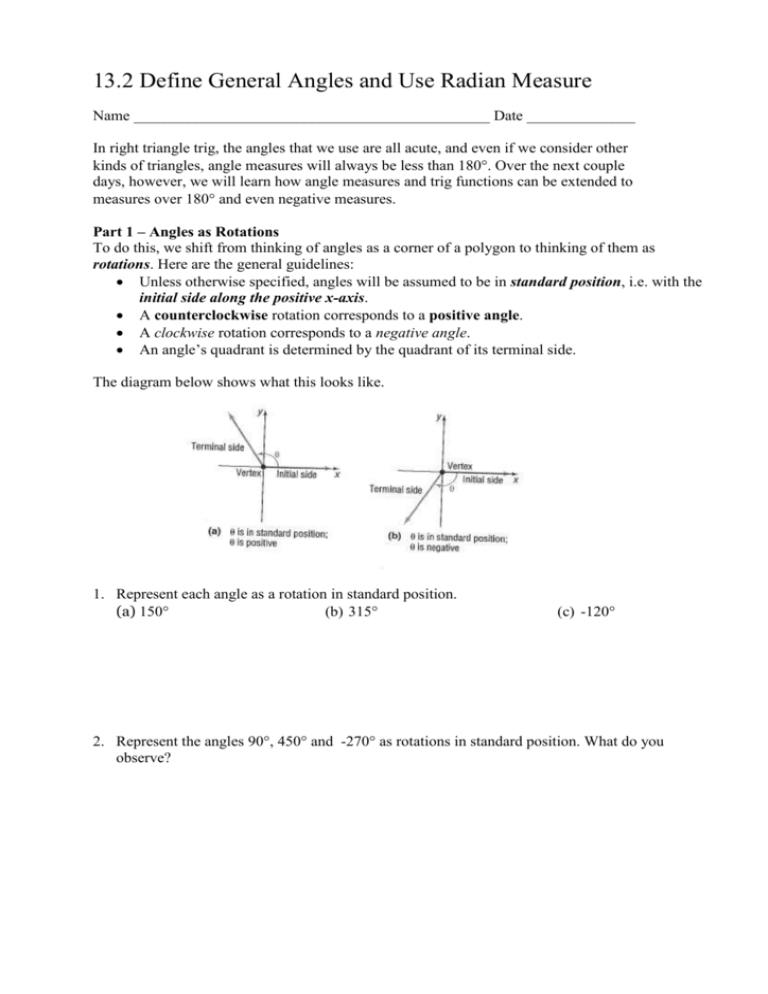
13.2 Define General Angles and Use Radian Measure Name ______________________________________________ Date ______________ In right triangle trig, the angles that we use are all acute, and even if we consider other kinds of triangles, angle measures will always be less than 180. Over the next couple days, however, we will learn how angle measures and trig functions can be extended to measures over 180 and even negative measures. Part 1 – Angles as Rotations To do this, we shift from thinking of angles as a corner of a polygon to thinking of them as rotations. Here are the general guidelines: Unless otherwise specified, angles will be assumed to be in standard position, i.e. with the initial side along the positive x-axis. A counterclockwise rotation corresponds to a positive angle. A clockwise rotation corresponds to a negative angle. An angle’s quadrant is determined by the quadrant of its terminal side. The diagram below shows what this looks like. 1. Represent each angle as a rotation in standard position. (a) 150 (b) 315 (c) -120 2. Represent the angles 90, 450 and -270 as rotations in standard position. What do you observe? Angles with the same terminal side are called coterminal angles. You can find coterminal angles by adding or subtracting multiples of 360. 3. Find one positive angle and one negative angle that is coterminal with the given angle. (a) 315 (b) -120 4. Write a formula for the measures of all angles coterminal with 150. It’s time for a brief look at how this works with trig. We’ll do a lot more of this in the next couple lessons. 5. Draw an angle in standard position whose terminal side passes through P(8, 6). Then find the values of the six trigonometric functions of . [Can you see how to draw in a right triangle? The terminal side becomes the hypotenuse.] Part 2 – Radian Measure Angles can be measured in degrees or in another kind of unit called radians. As we will see in Chapter 14, radians are generally used in non-geometric applications of trig. Here is a definition of a radian. First study the circle centered at the origin with radius r. An angle of one radian is the measure of q in standard position whose terminal side intercepts an arc of length r. (Think of it as the angle of a pizza wedge that is created by two congruent sides of length r where the length of the crust is also r…sort of like an equi-“lateral” piece of pizza.) This gives a conversion of 1 radian » 57.3 . Because the circumference of a circle is 2p r , there are 2p radians in a full circle. Degree measure and radian measure are therefore related by the equations 360 = 2p radians, or 180 = p radians. This conversion based on is much more commonly used than the 57.3 one noted above. Here are the steps to follow to convert between degrees and radians: To Convert Degrees to Radians: Multiply degree measure by p radians 180 To Convert Radians to Degrees: Multiply radian measure by 180 p radians 6. Convert to radians. (a) 210 (b) 270 7. Convert to degrees. 7p (a) radians 9 (b) - p 12 The diagram below shows a unit circle (radius = 1 unit) showing radian measures for the multiples of the special angles 30 , 45 , 60 , 90 . Write the corresponding degree measure next to each radian measure the unit circle. 8. Evaluate the trig functions. Can you do this without a calculator? (a) cos p 3 (b) sin p 4 (c) tan p 6 Part 3 – Arc length and area of a sector Do you recall from geometry what a sector is? A sector is a region of a circle that is bounded by _______ _______________ and an arc of the circle. 9. Consider a circle of radius 10 cm, and a sector of this circle whose central angle is 100. Make a diagram, then find the arc length and area of the sector. Write formulas for the arc length and area of a sector for a central angle measured in degrees. There are different versions of these two formulas if q is measured in radians. Arc Length of a Sector: s = r ×q Area of a Sector: A= 1 2 r ×q 2 10. Find the arc length and the area of a sector with a central angle of 2p and a radius of 5 25 cm. 11. A scientist performed an experiment to study the effects of gravitational force on humans. In order for humans to experience twice Earth’s gravity, they were placed in a centrifuge 58 feet long (that is, the diameter is 58 ft) and spun at a rate of about 15 revolutions per minute. (a) Through how many radians did the people rotate each second? (b) Find the length of the arc through which the people rotated each second.
